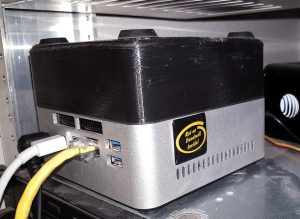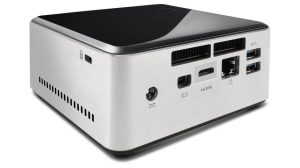Challenge
Like many others in IT, I keep a lab environment at home where I can try out ideas without the cost of company down time. Let’s face it, I have a hobby I get paid for! Anyways, my Microsoft Active Directory installation was on a pair of SuperMicro 1U machines. They were loud, consumed a lot of power and created quite a bit of heat too. Something was going to have to go but I really needed to have the lab machines.
After introducing my employer to virtualization, I needed to find a way to bring it home. I had rolled out VMWare to 30 grocery stores and did a “Physical to Virtual” (P2V) conversion on 20+ machines in the data center so this was not going to be a problem in the home lab.
My main problem was going to be finding a quiet host with low heat output.
Solution
At a VMWare event, the instructor was showing off a set of VMWare hosts all running their new distributed storage system. What I really found interesting was the demo was all running on Intel NUC machines. This link goes to my Spiceworks write up on migrating over to this silent giant.
Intel NUC machines come in several different configuration options. For my VMWare home lab, I needed a minimum of 16GB of RAM, a CPU that could handle virtualization and a internal SSD hard drive. The unit I chose was a barebones unit and waiting for all the pieces to be delivered was like waiting for Christmas.
I not only installed an internal SSD hard drive but added a 64GB second drive in the PCIe slot to use as a boot drive. This provided separation of the two volumes and allows for smoother upgrades of the VMWare OS.
Not entirely perfect
Since this project was build in the later part of the year, the weather was cool and there was no problem with overheating. Later on in the year, I started experiencing odd system crashes with the VMWare kernel. By sending the logs from the hosted Windows machines as well as the VMWare syslog to an outside machine, I was able to work out the time frame when the NUC would crash – Late in the morning when the room temperature was over 85 degrees.
This cannot be an isolated problem. I also have a 3D printer and use it to fabricate one off parts or short run production. There is a pattern repository called Yeggi where 3D designers share their designs and this is where I found a pattern for a fan that fits on to the Intel NUC frame. I found that the best cooling for my unit was to remove the top plate and use the fan on top. By powering the 12V fan using a 5V USB adapter, I keep the fan RPM low enough to not be noisy while still moving enough air to avoid the system crash.

Conclusion
I hope this has helped with other IT professionals trying to get your home labs going. Having the ability to spin up a machine for education and tinkering is extremely important to keeping your edge.
Even after using this platform for several years the little box keeps performing – I most recently installed a Rapid7 Nexpose machine to keep my security skills up to date and used one of the Windows machines to install DesktopServer as a WordPress development platform!

